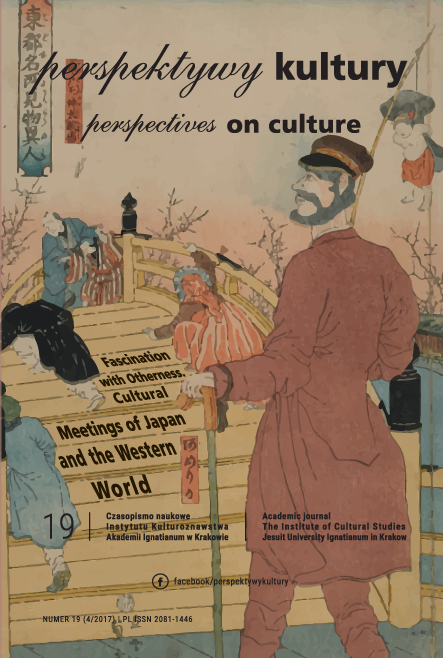Wschód spotyka Zachód, a później go oddaje: los „czystej literatury” w erze globalnej
Abstrakt
W ramach zamysłu stworzenia nowoczesnej „podmiotu”, który zalud- ni odnowione w zachodnim stylu państwo, w okresie Meiji (1868-1912) literaci japońscy entuzjastycznie rozpoczęli odkrywanie swojego oso- bistego „ja”. Czerpiąc ze wzorca europejskiej powieści realistycznej, zdołali nie tylko wykreować współczesne shōsetsu, ale i równie nowy język, w którym powstawały takie powieści. Ich prace stały się znane jako junbungaku lub „czysta literatura”. Pisana dla, przez i o Japoń- czykach, junbungaku była odbierana jako ściśle japoński sposób wy- razu artystycznego.
Ta tendencja zaczęła się zmieniać w 1979 r., wraz z debiutem współczesnego powieściopisarza Harukiego Murakamiego. Tworząc swój literacki krajobraz przy użyciu zachodnich modeli, Murakami odrzucił strukturę junbungaku („przez/dla/o Japończykach”), odkry- wając bardziej światowy podmiot, osadzony w hybrydowej koncepcji podmiotu ze Wschodu i Zachodu jednocześnie. Murakami najpierw spotkał „Zachód”, a następnie „oddał” go jako nową, hybrydową fik- cję, która porzuca spolaryzowane idee „Wschodu” i „Zachodu” i uka- zuje jako prawdziwie światowa forma literatury. Wyszydzane przez niektórych tradycjonalistów jako „śmierć junbungaku”, dzieło Mura- kamiego zostało jednocześnie ogłoszone odrodzeniem poważnej lite- ratury światowej.
Bibliografia
Chang, M. 2009. “Taiwanjin no Murakami Haruki: ‘Bunka hon’yaku’ to shite no Murakami Haruki genshō” (The Taiwanese people’s Murakami Ha- ruki: The Murakami Haruki phenomenon as ‘cultural translation’). In Fujii S., ed., Higashi Ajia ga yomu Murakami Haruki (Murakami Haruki as read in East Asia). Tokyo: Wakakusa Shobō, pp. 35-67.
Duus, P. 1976. The Rise of Modern Japan. New York: Houghton Mifflin. Fujii, S., Numano, M., Shibata M., and Yomota, I. 2006. “Naze sekai wa Murakami Haruki o yomu no ka” (Why is the world reading Murakami Ha- ruki?). In Shibata M., ed., Sekai wa Murakami Haruki o dō yomu ka (How does the world read Murakami Haruki?). Tokyo: Bungei Shunjū, pp. 1-10. Gordon, Andrew. 2003. A modern history of Japan: From Tokugawa Times to the Present. Oxford and New York: Oxford University Press.
Guth, C. 1997. “Some reflections on the formation of the Meiji artistic ca- non.” In Hardacre, H. and Kern, A.L., editors, New directions in the study of Meiji Japan. Leiden, New York, Köln: Brill, pp. 35-41.
Henshall, K. 2013. In search of nature: The Japanese writer Tayama Katai. Leiden and Boston: Global Oriental.
Hirano, K. 1961. Junbungaku to taishū bungaku (Pure literature and mass lite- rature). Gunzō (Dec.), pp. 154-172.
Hirano, K. 1972. Bungaku: Shōwa jūnen zengo (Literature: Around 1935). Tokyo: Bungei Shunjūsha.
Iser, W. 1980. The act of reading: A theory of aesthetic response. Baltimore and London: The Johns Hopkins University Press.
Karatani, K. 1990. Shūen o megutte (Concerning endings). Tokyo: Fukutake Shobō.
Keene, D. 1998. Dawn to the West: Japanese literature in the modern era. New York: Columbia University Press.
Kim, Y. 2009. Kankoku ni okeru Murakami Haruki no juyō to sono konte- kusuto (Murakami Haruki’s reception and its context in South Korea). In Fujii, S., ed., Higashi Ajia ga yomu Murakami Haruki (Murakami Haruki as read in East Asia). Tokyo: Wakakusa Shobō, pp. 7-34.
Kurahashi, Y. 1986. Amanonkoku ōkan-ki (Chronicle of the Amanon highway). Tokyo: Shinchōsha.
Mair, V (ed.). 2001. The Columbia history of Chinese literature. New York: Co- lumbia University Press.
Mishima, Y. 1966. Eirei no koe (Voices of the heroic dead). Tokyo: Kawade Shobō.
Murakami, H. 2015. Shokugyō to shite no shōsetsuka (The professional nove- list). Tokyo: Switch Library.
Ōe, K. 1989. Japan’s dual identity: A writer’s dilemma. In Miyoshi, M. and Harootunian, H., eds., Postmodernism and Japan. Durham, N.C.: Duke University Press.
Ōe, K. 1977. Teach us to outgrow our madness. Nathan, J., trans. New York: Grove Press.
Orbaugh, S. 2003. The problem of the modern subject. In Mostow, J., editor, The Columbia companion to modern East Asian literature. New York: Co- lumbia University Press, pp. 24-35.
Rubin, J. 1979. Soseki on individualism: “Watakushi no kojinshugi.” Monu- menta Nipponica 34.1 (Spring), pp. 21-48.
Strecher, M. 1996. Purely mass or massively pure? The division between “pure” and “mass” literature. Monumenta Nipponica 51.3 (Autumn), pp. 357-374.
Strecher, M. 2002. Arishima Takeo’s “Sengen hitotsu” and the origins of the proletarian literature debate. Gengo to bunka No. 2, pp. 241-265.
Strecher, M. 2002. Dances with sheep: The quest for identity in the fiction of Mu- rakami Haruki. Ann Arbor: Center for Japanese Studies, University of Mi- chigan Press.
Sugimoto, Y. 1999. Making sense of Nihonjinron. Thesis Eleven, No. 57 (May), pp. 81-96.
Takagi, M. 1985. Zengakuren to zenkyōtō (Zengakuren and zenkyōtō). Tokyo: Kōdansha Gendai Shinsho.
Tanaka, H. 2001. Cézanne and “Japonisme.” In Artibus et Historiae 22.44, pp. 201-220.
Twine, N. 1991. Language and the modern state: The reform of written Japanese. London and New York: Routledge.
Walker, J. 1997. Reflections on the entrance of fiction into the Meiji literary canon. In Hardacre, H. and Kern, A.L., editors, New directions in the study of Meiji Japan. Leiden, New York, Köln: Brill, pp. 42-44.
Copyright (c) 2017 Akademia Ignatianum w Krakowie

Utwór dostępny jest na licencji Creative Commons Uznanie autorstwa – Bez utworów zależnych 4.0 Międzynarodowe.
Autor, zgłaszając swój artykuł, wyraża zgodę na korzystanie przez Wydawnictwo Uniwersystet Ignatianum z utworu na następujących polach eksploatacji:
- utrwalania utworu w formie papierowej, a także na nośniku cyfrowym lub magnetycznym;
- zwielokrotnienia utworu dowolną techniką, bez ograniczenia ilości wydań i liczby egzemplarzy;
- rozpowszechniania utworu i jego zwielokrotnionych egzemplarzy na jakimkolwiek nośniku, w tym wprowadzenia do obrotu, sprzedaży, użyczenia, najmu;
- wprowadzenia utworu do pamięci komputera;
- rozpowszechniania utworu w sieciach informatycznych, w tym w sieci Internet;
- publicznego wykonania, wystawienia, wyświetlenia, odtworzenia oraz nadawania i reemitowania, a także publicznego udostępniania utworu w taki sposób, aby każdy mógł mieć do niego dostęp w miejscu i czasie przez siebie wybranym.
Wydawca zobowiązuje się szanować osobiste prawa autorskie do utworu.





